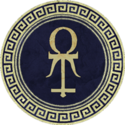Seleucid Empire (Eordisverse): Difference between revisions
BattlerNonna (talk | contribs) (Created page with "{{Infobox former country |native_name = <!-- Name in a modern syntax of native language(s). Leave blank if name is only in English....") |
BattlerNonna (talk | contribs) mNo edit summary |
||
| Line 145: | Line 145: | ||
* {{flagicon image|Militesi_flag.png |22px}} Militesi Empire | * {{flagicon image|Militesi_flag.png |22px}} Militesi Empire | ||
* {{flagicon image|East europan imperial alliance 11666.jpg|22px}} [[Autocratic East Europan Imperial Alliance]] | * {{flagicon image|East europan imperial alliance 11666.jpg|22px}} [[Autocratic East Europan Imperial Alliance]] | ||
* {{flagicon image|RamunciaFlag.png|22px}} [[Ramuncia]] | |||
* {{flagicon image|Communist Lorica.png|22px}} [[Lorica]] | * {{flagicon image|Communist Lorica.png|22px}} [[Lorica]] | ||
* {{flagicon image|Flag of Vepsia.svg|22px}} [[Kyachindwin]] | * {{flagicon image|Flag of Vepsia.svg|22px}} [[Kyachindwin]] | ||
Revision as of 22:30, 28 March 2019
Seleucid Empire Empire of Seleucia and Babelon | |
|---|---|
| 312 BC–419 AD | |
|
Shield of the Seleucid army; also used in banners. | |
| The Empire at its greatest extent under the reign of Seleucus XIII Heraclytenus, 223 AD The Empire at its greatest extent under the reign of Seleucus XIII Heraclytenus, 223 AD | |
| Capital | Seleucia (312 BC – 250 BC; 34 BC – 395 AD) Anacletia (250 – 34 BC; 395 – 419 AD) |
| Common languages | |
| Religion |
|
| Government | Monarchy with elements of a Republic |
| Basileus | |
• 312 – 285 BC | Seleucus I Callinicus |
• 415 – 419 AD | Philip XI Doson |
| History | |
| 321-312 BC | |
• Establishment of the State | 312 BC |
| 57 BC | |
• Darscen Revolt | 167 – 160 BC |
| 34 BC – 75 AD | |
| 53 – 60 AD | |
| 419 AD | |
| Currency | Seleucid Drachma |
| Today part of |
|
The Seleucid Empire, also known as the Empire of Seleucia and Babelon, was a successor state that existed from 312 BC to 419 AD after the Macedonnan Empire formed by Alexandros the Great split apart. It was ruled by the Seleucid Dynasty, with Seleucus I Callinicus as its founder.
The Empire was responsible for being the significant center of Grecian culture.
History
Establishment of Dynastic Rule by Seleucus I and Anacletus I
Expansions by Cassander I the Great and Seleucus II Philadelphus
First Golden Age
First Dynastic Crisis
Dionysean Restoration
Expansions by the Anicetids
Second Golden Age
Strife Era
Athenadoric Restoration
Second Dynastic Crisis
Further Decline and Fall
Government
Rule of the Monarch
The Boule
- One satrap
- 2-5 advisory members depending on size of satrapy
Culture
Technology
Economy
Coinage
Trade
Dath'Remar's Empire
Ahushomr'Thalas
Lorica
Indiae
Quenmin
Joyonghea
Bethausian City-States
Legacy
Science
Architecture
Art
Politics
Influence on Yggdism
Aside from Dath'Remar, the Seleucids have left a significant impact on the Yggdist religion. Due to their cordialness towards the Darscens, their wars against the Valkyrur, and their desire for obtaining the powers of the Valkyrur, its belief system and texts have condemned them for the aforementioned, and are branded as an evil empire. Quite similar to Dath'Remar, several of the celebrated monarchs, which are Seleucus IX, Seleucus XI, Anacletus XII, Seleucus XII, Philoxenus II and their descendants have been portrayed as devils in the flesh, with the first being the original and worst. Being that they have beared the Staff of Seleucus, this inheritance has been used to certify and justify their portrayals as enemies of the Valkyrur.
An epistle by one of the Yggdist practitioners, Thellos Quietspell, describes this concisely in the introduction:
In our faith, there were three great enemies of the Valkyrur: the Darscens, the Dath'Remarids, and the Seleucids. And from these enemies, there were three great devils that dared to challenge their divine place: Menashe ben Aviram, Dath'Remar, and Seleucus Anicetus.
— Thellos Quietspell, Valkyrur Epistle IV, Verses 3 and 4
Moreover, the derogatory term "seleucid" has been derived from the Empire and dynasty's name and has been used against those that denounce the divinity of the Valkyrur and have associated with or assisted Darscens. It's usage was first recorded in the 9th Century, when Yggdism began to spread throughout Europa.
